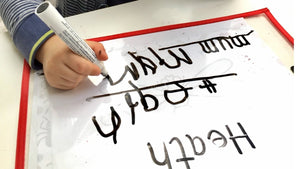The Importance of Handwriting

Why is handwriting important?
Handwriting is an immediate, easy (for most) and inexpensive way of recording language. In addition, it confers a number of cognitive, social and emotional benefits on the writer: It is a personal and expression of the individual; it has a calming effect and can assist emotional communication; it helps to organise written thoughts, stimulate creativity, assist memory and improve written composition in a number of different ways. It also has a beneficial impact across the curriculum.
When should the teaching of letter formation begin?
Letter formation should begin as soon as a child is able to recognise different letter shapes, perhaps even before s/he is proficient with a writing implement. It is vital that the correct movements for forming the letters are taught and practised (even with paint, sand, glue, play dough, etc). This will support memory for the letters, reduce directional confusions, such as b and d, and speed up writing with pencil and pen later.

Is there still a place for handwriting in a digital age?
Do you think there is a place for handwriting apps?
Like all skills with a motor component handwriting needs to be practised. Good apps can be a platform for practise and although research has found that they are not more effective at teaching than pencil on paper, they have been found to be highly motivating, especially for those who struggle.

Do you think there has been a decrease in the overall level of handwriting?
A reduction in handwriting standards was noticed at the beginning of this century, in part because it was not valued and often not taught. However, more informed understanding of its importance, based on solid research findings, has led to an increase in status of the skill and it is now much better taught on the whole.
What would you change about the way handwriting is taught?
Increasing enthusiasm for fluency and speed has led, in many schools, to detrimental practice which is misguided and may constrain proficiency. One common example of this is the practise of teaching continuous cursive style from reception. This usually includes the teaching of cursive letter forms with a baseline entry stroke. Teachers may choose this style in the belief that it will increase fluency later but there is no evidence to support this.
Furthermore there is a growing body of evidence showing that this particular approach can be difficult for a child to adopt and it can cause confusion over the learning of letterforms and interfere with legibility. A better approach, and that given in the National Curriculum is to teach simple letterforms without an entry stroke at first, then to teach the joining strokes once these have been established. It is also practical to recognise that for greatest speed and legibility there are certain letters which may be best left unjoined.

Is letter tracing and directional arrows helpful in aiding letter formation?
Letter tracing has a place in the teaching of handwriting but as soon as they can children should be encouraged to perform the letters from memory, even if the motor delivery is not fully controlled.
Sound research has found that after Reception, teaching which involved language, mnemonics, pattern and cues such as directional arrows are much more effective than tracing or a multi-sensory approach.
Any tips for left-handed writers?
Left handlers may take longer to establish fluent handwriting. They may also experience practical barriers, such as covering their work so that they can not monitor what they are doing. Angling the page up to 45’ to the right can help and there are a range of pens in the market which left-handers may find easier to use.
Any tips for letter reversals such as for the letters 'b' and 'd'?
In the past it has been commonplace to teach these two letters together, using mnemonics such as ‘bat and ball’, to assist recall. However, research suggests two amendments:
- Any mnemonic must include a clear and specific directional component - bats and balls, ducks and drakes, may face any direction! Better to talk about ‘curving to the LEFT’ etc.
- Teaching opposites together may result in ‘cross-talk’, i.e. one can be 50% right or wrong at any time.
It is better to focus on one, embedding it in the movement group it belongs to (e.g. d belongs to the curly caterpillar group starting with a curve to the left, like c, o, a, g, q.) Teach and practise with these letters until it is firmly established. Later, b should be taught with its letter family which starts with a vertical stroke down, r, n, m, p, h and b.
Thank you Angela!

